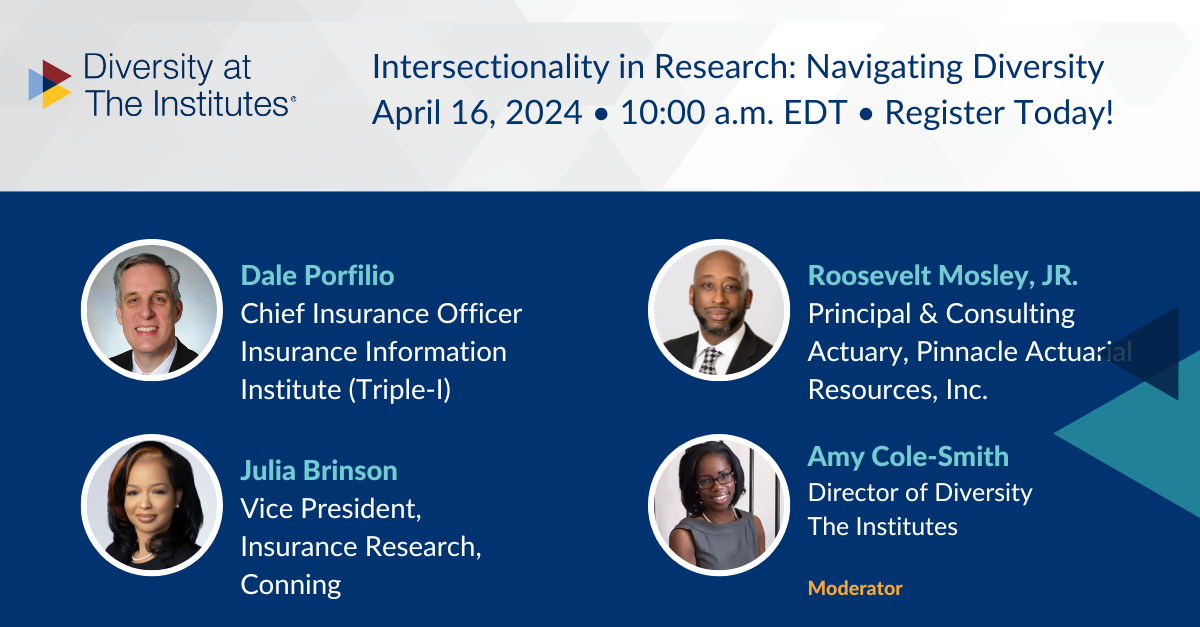
Industry stakeholders looking to keep pace with market challenges may find diversity in research the key to long-term success and resilience. A multitude of different perspectives, ideas, and solutions can enhance innovation and strategic outcomes. Join The Institutes for a webinar panel discussion of strategies for creating inclusive research spaces, addressing biases, and fostering a diverse and equitable research community, specifically in insurance.
The panel includes:
- Julia Brinson, Vice President, Insurance Research, Conning
- Dale Porfilio, Chief Insurance Officer for the Insurance Information Institute (Triple-I) and President of the Insurance Research Council (IRC).
- Roosevelt Mosley, Jr. Principal & Consulting Actuary, Pinnacle Actuarial Resources, Inc.
Amy Cole-Smith, currently the Director for Diversity at The Institutes, moderated the discussion for this on-demand event.
Intersectionality hinges on two core fundamentals: all oppression is linked, and people can be impacted by multiple sources of interlocking oppression that converge to create a new and multi-layered struggle.
For example, intersectionality recognizes that a Black woman experiences racial and gender discrimination in ways that might be entirely different from the ways Black men face racism or White women face sexism. These differences stem from the principle that for Black women, the identities of “woman” and “Black” do not exist independently.
Intersectional research explores how gender, race, ethnicity, and other identity markers impact the data and analysis to drive valuable insights. But success requires discovering effective ways to generate those insights for the benefit of all in the customer base, not just some. Without the inclusion of intersectionality in research, disparities may continue, and market needs–along with accompanying opportunities–can go unmet.
According to Julia Brinson, applying intersectional research begins with better recruiting diverse talent. Building on her response, Roosevelt Mosley, Jr added, “Once that talent gets into our industry, we need to focus on developing and growing that talent into all areas of an organization.”
In a demonstration of how inclusion can play out around the research table, the panelists shared how their experiences influence how they approach research. Brinson, who holds a Master of Law in Insurance Law (among many other credentials), spoke about how she views insurance research problems with an eye for diversity using a “legal lens to understand the claims aspect” and how premiums may be affected.
The panelists also recommended how other researchers can effectively incorporate intersectionality into their work.
Dale Porfilio commented on how “diversity in thought and experience” can help address the industry’s challenges in this area, including “making sure products are affordable…and available to cover a broad range of risk…and integrating that with the social construct of fairness.”
However, Moseley warned that a one-size-fits-all approach to any particular category, such as race, gender, etc., won’t be sufficient to meet the requirements of intersectionality in research.
“There is a collective experience of groups, but within that collective experience, there is also significant diversity,” he said.
The common sentiment revolved around the need for “courageous conversations” and there was plenty of advice on how institutions foster an environment that promotes communication and collaboration among researchers of diverse backgrounds.
The entire webinar is available now on demand. Register here: Intersectionality in Research: Navigating Diversity (on24.com)

